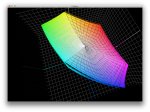Agree with Gordo that Apple products are pretty good at displaying achievable color.
Problem I have seen repeatedly over the last 25 years is when a designer shows the customer output from their uncalibrated wide gamut desktop printer on stock nothing like the job is printing on. Customer loves the color which becomes the target for the proof/press. Got one just today........
I know what you mean. I had a customer that would supply a proof from their desktop inkjet printed on copy paper for jobs that would print on 100lb coated stock and want us to match it.














